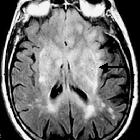hemimegalencephaly
















Hemimegalencephaly is a rare congenital disorder of cortical formation with hamartomatous overgrowth of all or part of a cerebral hemisphere. This results from either increased proliferation or decreased apoptosis (or both) of developing neurons .
Epidemiology
Hemimegalencephaly is a cryptogenic congenital disorder and does not have a recognized racial or gender predilection . It is rare, accounting for only ~0.2% of cases of childhood epilepsy .
Clinical presentation
The majority (90%) of patients present with focal and generalized infantile spasms. Developmental delay, hemiparesis, and hemianopia are usually also evident .
Although normocephaly is often present, macrocephaly may be pronounced and normal vaginal delivery may be impossible. Despite the markedly enlarged head, there are no symptoms of raised intracranial pressure .
Classification
Hemimegalencephaly is divided into three forms :
- isolated
- syndromic: associated with a variety of syndromes typically including hemihypertrophy of the ipsilateral part of the body
- epidermal nevus syndrome
- Klippel-Trenaunay Syndrome
- McCune-Albright syndrome
- Proteus syndrome
- unilateral hypomelanosis of Ito
- neurofibromatosis type 1 (NF1): rare
- tuberous sclerosis: rare
- CLOVES syndrome
- total hemimegalencephaly: hemihypertrophy also involves the brainstem and cerebellum
Pathology
It is a congenital malformation in which defective cellular organization and neuronal migration result in hamartomatous overgrowth of a hemisphere. Macroscopically the affected hemisphere demonstrates, in addition to overgrowth, abnormal cortical development is present with areas of lissencephaly, agyria, pachygyria and polymicrogyria in varying proportions, with other areas appearing normal .
Radiographic features
All modalities able to image the brain (ultrasound, CT and MRI) will be able to more or less identify the key features, although MRI will give the best imaging. Typical features of the affected hemisphere include :
- increased lateral ventricle size: sometimes may be small
- shallow sulci enlarged gyri
- enlarged/thickened calvaria
- contralateral displacement of the posterior falx
- white matter calcification
- associated with developmental venous anomalies (DVAs)
The cortex of the involved hemisphere may be normal, but often demonstrates :
Nuclear medicine
Brain SPECT and PET both demonstrate hypometabolism in the affected hemisphere .
Treatment and prognosis
Treatment is targeted to the control of epilepsy, which can be difficult to manage medically. In refractory cases hemispherectomy is the treatment of choice and results in seizure control in at least 60% of cases when carefully selected; patients with contralateral malformations have a poorer surgical outcome .
Differential diagnosis
- enlarged hemisphere
- small hemisphere, making the normal hemisphere appear large
- other neuronal migration anomalies without overgrowth
Siehe auch:
- Gliomatosis cerebri
- Tuberöse Sklerose
- Sturge-Weber-Krabbe-Syndrom
- Polymikrogyrie
- Lissenzephalie
- Dyke-Davidoff-Masson syndrome
- Proteus-Syndrom
- Megaloenzephalie
und weiter:

 Assoziationen und Differentialdiagnosen zu Hemimegalencephalie:
Assoziationen und Differentialdiagnosen zu Hemimegalencephalie:






